DO-IT News December 2011

Volume 19, Number 2
Below are the articles of the DO-IT News December 2011 newsletter. These articles can also be seen all on one page at the Full Newsletter option.
Director's Digressions
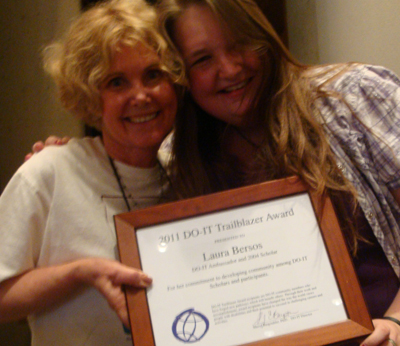
DO-IT Trailblazer Awards highlight DO-IT community members who forge new pathways that will benefit others. We select individuals who, through their work and accomplishments, have changed the way the world views people with disabilities and have increased their potential to succeed in college, careers, and community life. Congratulations to this year's honorees!
Laura Bersos, DO-IT Ambassador and '04 Scholar, was awarded the Trailblazer Award for her work developing community among DO-IT Scholars and participants. Laura has attended Summer Study activities every year since she became involved with DO-IT and helps new Scholars feel welcome.
Kayla Brown, DO-IT Ambassador, '05 Scholar, and DO-IT student staff member, has been involved in advocacy work at Bellevue College. She advocates for the rights of people with disabilities in Seattle and has traveled to New Orleans to help rebuild the city after Hurricane Katrina. Kayla has participated in City Year where she worked with teenage students, and has served on the A-Team leadership group for DO-IT's AccessSTEM project.
E.A. Draffin, research staff in the University of Southampton's School of Electronics and Computer Science in the United Kingdom, is a Trailblazer for promoting accessibility in e-learning, the web, and mobile devices; providing an international database of accessible technology; and supporting students with disabilities through her efforts to increase accessibility in education, employment, and daily life.
Goodbye, Doug
It is with great sadness that I report that our long-time DO-IT Mentor Doug Lefever died from injuries sustained when hit by a hit-and-run driver while in a crosswalk on a Seattle street this October. DO-IT, which began in 1992, had barely started when Doug volunteered to mentor DO-IT Scholars. He was an excellent role model when it came to earning a college degree and making positive contributions to DO-IT and to the Seattle community overall.
Doug received the DO-IT Mentor Award as well as the Hunthausen Humanitarian Award. Doug was also profiled in the University of Colorado alumni magazine.
Doug will be missed by the DO-IT family and especially by those for whom he provided encouragement and guidance. We remember his great sense of humor that was apparent when he was hit in the chest by a foul ball during a DO-IT Summer Study trip to a Mariners game. Doug later confided that getting that signed ball made it worth getting hit. In true mentor form, he stated that if the ball was to hit someone in the row of wheelchair-users that night, it was good that it was him; everyone else in the row was a DO-IT Scholar.
Goodbye, Silvia
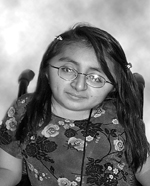
Silvia passed away in January of 2011 after living a full but short life, overcoming many challenges to achieve success, and sharing her positive attitude with everyone she met.
Silvia, an '02 DO-IT Scholar, was born with osteogenesis imperfecta, which causes brittle bones. She attended high school in Royal City, WA, where she was a member of the National Honor Society. Sylvia pursued a bachelor's degree in business at Eastern Washington University until health issues forced her to move out of a dorm and back home. But her declining health didn't stop her for long. Determined to continue pursuing her college degree she enrolled in distance learning classes through Big Bend Community College.
Silvia was adventurous. She met life's challenges head on and never gave up. Her inspirational attitude will continue to inspire all of us in the DO-IT family.
Summer Study: What Do Phase I Scholars Do?
DO-IT Phase I Scholars participate in a two-week, live-in Summer Study session on the UW Seattle campus. They learn about college life; explore the Internet; interact with peers, staff, and mentors; and have fun. The DO-IT Scholars program started in 1993 as an experimental project for teens with disabilities nationwide. It is currently open to Washington State teens and is supported by the State of Washington, the Boeing Company, the Microsoft Corporation, and the National Oceanic and Atmospheric Administration.
The First Night at DO-IT Summer Study
On the first night of Summer Study, Phase I Scholars were a little nervous as to what was to come. Although we were excited, we did not know what was in store for us. First, we had orientation with our families. Then we had delicious dinner that was gone pretty quickly! After dinner we had an icebreaker where we met our fellow Scholars. After that the Interns held a success panel where we learned how to be successful at the DO-IT program and in life. Finally we had free time where we got to know our peers on a more personal level.
A Tour of the Botanical Gardens
"We are going to build a world," proclaimed the representative of the Seattle Botanical Gardens to the intrepid DO-IT Scholars. And it was so. No matter that the alleged world consisted of a small jar. The jar contained a new and original ecosystem, a manufactured one that would prosper in the responsible care of the DO-IT Scholars. Several plants were selected to form the basis of the ecosystem. Then soil was funneled in to serve as a foundation for the plants, so that they might retain nutrients from it. Lastly, worms and similar animals were placed within the jar to provide diversity to the ecosystem. Each and every one of the worms received a special and unique name.
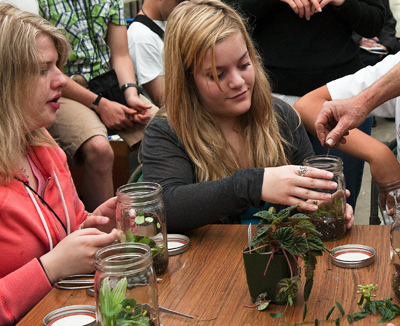
The DO-IT Scholars were impressed with the worlds they built, and they were equally impressed by the accessibility options available at the gardens. Interpreters for the deaf were available. There were also numerous helpers available to assist the blind in the activities. The choices for those in wheelchairs were somewhat limited, however, through no fault of the Botanical Gardens. It is housed in a building that was constructed long before the Americans with Disabilities Act. Nevertheless, many people with wheelchairs said that they didn't mind the limited accessibility, as most of the areas that were not wheelchair accessible were closed off to everyone.
Besides the world building activities, DO-IT Scholars learned about plants in arid areas, and, more importantly, the adaptations that they must make to survive in such a desolate climate. These adaptations particularly resonated with the DO-IT Scholars because it reminded them of their own disabilities and how they transcend such things. Like the plants, some people believed that the Scholars could not succeed in school, at home, in the social arena, and in life. But they were wrong; like the lowly cactus, people with disabilities can excel.
Microsoft Field Trip
Phase I Scholars had the opportunity to visit Microsoft. The day was filled with many activities. First, we met with Microsoft employees who talked about the different technology that they use during their work day. We also were introduced to two employees that have disabilities, one with low level vision and one who is blind. We had the chance to play with assistive technologies, including the Kinect. We created a robot dog designed to help people who are blind. The field trip gave us a better understanding of how people with disabilities can be successful in the technology industry.
Wheelchair Rugby
One of the activities we did at Summer Study was watch a game of wheelchair rugby. It's an interesting sport to watch. The sports facility was very accessible and the players were all very nice. After the game, we had the opportunity to use the chairs and play rugby with some of the team members.
Pacific Science Center
Phase I Scholars took a day-long trip to the Pacific Science Center. We watched Harry Potter 7: Part 2 in 3D, which was really cool. We were able to go inside the theater before the rest of the public so we could choose seats, and people using wheelchairs could get comfortable.
After the movie we walked through exhibits. In the butterfly exhibit many different species of butterflies were flying around. It was humid—that was good for the butterflies. There was an exhibit that is called Goose Bumps. It tests your fears in situations and explains how fear affects your body and your life. When they test your falling fear, they have a machine that makes you fall but it is very safe. There was a booth that tests your fear of touching a bug.
If you put your hand in a hole you feel the bug. The Center had ramps throughout, which made the facility very accessible. For those of us with hearing impairments that need higher volumes, the Center provided listening devices.
Returning to the Pacific Science Center
I loved the trip to the Pacific Science Center because it was my first time watching a movie in 3D. I had visited the Center as a child and was happy to go back to see the exhibits, it brought back great childhood memories.
My First Roommate
Have you ever wondered what rooming with other people is like? Phase I Scholars had the opportunity to find out when we attended the DO-IT Summer Study program this past summer.
Jae has cerebral palsy and Jessie has profound hearing loss and consequently use a cochlear implant. At first it was hard for us to interact with each other but, as time went by, we got along well. It was challenging at times, especially in the morning, because Jessie needed a vibrating alarm clock to wake up, while Jae needed special assistance for her morning routine. One of the reasons that we got along well is because Jae uses a communication device on her wheelchair so it is easy for Jessie to read what she is saying on her screen and understand her. If you are interested in rooming with other people, don't be afraid to do so. It can be fun!
Summer Study: What Do Phase II Scholars Do?
Phase II Scholars return to the UW Seattle campus for their second Summer Study. They meet the Phase I Scholars, learn about college life and career preparation, and participate in a one-week workshop with postsecondary instructors.
Germ Forensics
During Summer Study, five Phase I Scholars—Krysta, Nicco, Niki, Shawn, and Eric—spent their mornings learning about global health. This workshop was sponsored by Seattle BioMed, a non-profit dedicated to eradicating diseases in developing countries. The diseases Seattle BioMed focuses on are malaria, tuberculosis, and HIV/AIDS. The students learned how infectious diseases are spread and what is being done to treat and cure them.
We began the week by collecting bacteria samples that we then streaked in petri dishes to be looked at later in the week. We learned how bacteria and viruses attack our immune systems. When we are sick, it's not the virus making us sick but rather, our bodies reacting to the virus. Things like fevers and coughing are all things our bodies do to help kill the foreign cells.
On Wednesday, we took a trip to the Seattle BioMed lab where we used compound microscopes to look at bacteria cultures we collected earlier in the week, dissected mosquitoes, and toured the lab. Our tour guide explained to us the progress Seattle BioMed is making in developing a malaria vaccine. They have a vaccine already in clinical trials!
In addition to all of these things, we learned about how epidemiologists track diseases' origins, how to use micropipettes, and how to conduct ELIAS tests to look for HIV antibodies. We learned a lot about science and how we can make a difference in global health.
We would like to thank our teachers, Beth Solan and Magali Sanchez, and Seattle BioMed for giving us this amazing experience!
Phase II Neurobiology Workshop
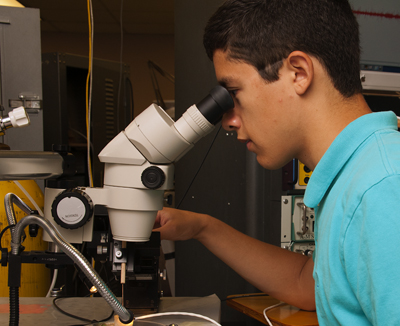
During the second week of Summer Study 2011, a group of Phase II Scholars participated in the Bugs, Mice, and Brains workshop. It was hosted at two labs at the University of Washington Medical Center and Kincaid Hall on the UW Campus. At the medical center, Scholars had the chance to complete a junior-level lab for neurobiology majors. This lab used sensitive electronics and amplifiers to measure electrical signals in cockroach neurons. The Scholars manipulated the spines on cockroaches to see how different stimuli can affect a cockroach's reaction and adaptation to the signal.
In the lab at Kinkaid Hall, the Scholars dissected and tested the hindbrain on a mouse embryo. The lab was set up to measure florescence in the embryo tissue. Scholars tested different drugs on the tissue and recorded how it reacted. Each of the workshops gave participants an opportunity to work in two real, functioning science labs and learn how to formulate hypotheses, test them, and draw conclusions from experiments.
Lights, Camera, Action!
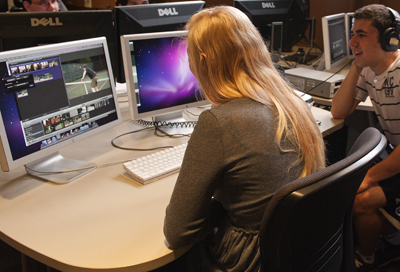
Some of the Phase II Scholars enrolled in a class called Lights, Camera, Action! In the class, they worked with high definition video cameras and edited the content using iMovie on Mac computers. Subject matter varied. Some students filmed events that were taking place during the week and then compiled them into one movie. Others made parody commercial segments involving common sodas we drink in our everyday lives. Tivon, the instructor, is from the University of Washington's DXArts program. His knowledge and insight really helped the students make a high quality video.
Collaborating Around the World
This fall I traveled to Asia to meet with education leaders and share DO-IT practices to help students with disabilities transition from high school to college and careers and to help educators make technology and academic courses welcoming and accessible to all students.
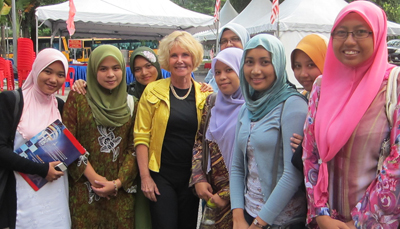
In Singapore, I engaged with faculty and students in special education at the National Institute of Education, a postsecondary education organization that trains teachers. We compared practices in the U.S., Korea, Japan, and Singapore regarding people with disabilities and discussed how we might further collaborate as part of DO-IT's international efforts. I also shared information about some of our special efforts, including AccessComputing and AccessSTEM, National Science Foundation-funded projects developed to increase the participation of people with disabilities in computing fields and in science, technology, engineering, and mathematics (STEM). Next, I visited the IT Accessibility Center at the Society of Physically Disabled. I toured their assistive technology showroom and observed students participating in their program to train individuals with disabilities for technology-related jobs.
At the University of Malaya in Kuala Lumpur, I delivered the keynote address and several other presentations at its international workshop on special needs education. One presentation on accessibility features of mainstream computers was co-presented by Dr. Mamoru Iwabuchi, a representative from our DO-IT program at the University of Tokyo. In a dinner hosted by the University, Mamoru and I brainstormed ideas with leaders in Malaysia regarding how they can best begin DO-IT programs there and adjust activities in response to cultural issues and access approaches in Malaysia. These leaders have secured a grant from the Malaysian government to begin DO-IT activities there.
Learning how others around the world are addressing issues we care about continues to inform our practices at DO-IT. DO-IT is particularly attractive to the Asian countries we have worked with because our practices in using technology, addressing transition issues, and developing self-determination skills are flexible enough to adapt to their cultures.
Individuals and organizations are encouraged to replicate DO-IT practices worldwide. To get started, potential partners are encouraged to consider the following actions:
- Develop a support program for youth with disabilities that includes residential study on a college campus, in-person and online peer and mentor support, internships and other work-based learning, and access to computers and assistive technology.
- Promote the development of and use of technology for people with disabilities.
- Encourage the practice of universal design of instruction, physical spaces, technology, and services.
- Employ strategies to promote institutional change.
To continue to be informed of our international efforts to promote the development and use of technology and college and career success for people with disabilities, join DO-IT's international discussion list by sending an email to doit@uw.edu. For more information on international collaboration at the DO-IT Center, visit DO-IT International Initiative.
Ambassador Profile: Heidi
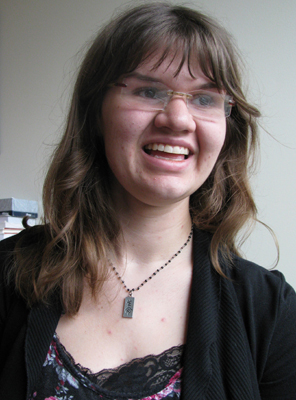
Hello, my name is Heidi Wangelin, and I am a DO-IT Ambassador and an AccessSTEM member. I live in Redmond, WA. I have Asperger syndrome and a non-verbal learning disorder. I graduated from Cascadia Community College this June with faculty honors, was a part of the Phi Theta Kappa honor society and was a club representative for my school's disability club called Access Futures. I attend the University of Washington, Bothell, and I am majoring in culture, literature, and the arts. I hope to eventually go on to earn a master's degree in library science at the University of Washington's Seattle campus. I was recently nominated for the All Washington State Academic Team for Two Year Colleges and Technical Colleges and as a result received a University of Washington All-Academic Team scholarship, which means I was one of the first ten people from the team to be accepted into the University of Washington. I also participate in the University of Washington, Bothell's Disability Student Strengths Alliance as one of the founding members. I am interested in the neurodiversity movement, which is a movement that believes that invisible disabilities are differences to be celebrated and that people with these disabilities have the freedom to express ourselves. I have been on a few DO-IT panels including one at Ryther's Children Center in Seattle and was a Summer Study session leader for the College Life group this year. What I like best about DO-IT is how it prepared to me to self advocate and helped me refine my computer skills, a necessary skill in library science. I have also made many wonderful friends through DO-IT that I see often.
I am currently working with Penny Hinke, a DO-IT staff member who specializes in study coaching. Working with Penny has helped me learn time management as well as managing my school, family, and social life.
I love being part of DO-IT and hope others will have the support I have had.
Awards and Recognitions Received by DO-IT Scholars and Ambassadors
DO-IT Scholars and Ambassadors are often recognized for their hard work, academic achievements, and leadership. Some examples of recent awards include the following:
- Angela serves as an honor society officer at her school.
- Benjy was awarded the Corey Lux Scholarship.
- Damon is vice-president of his school's honor society.
- Erik was named Rotary student of the month at his school.
- Heidi graduated from community college with honors and was nominated for the All Washington State Academic team.
- Jenica was elected vice president of her school's DECA chapter, awarded Rotary student of the month, and also was elected president of her school's Knowledge Bowl team.
- Maximo is a member of the honor society at his school.
- Nicco was elected student lead for the robotics program at his high school.
- Niki earned the Unbeaten Award.
- Nohemi was awarded a scholarship from the PEO Foundation and the Chair Scholars Foundation.
- Ryan B. received the Defense Contract Management Agency Commanders Coin and "One Team" award.
- Ryan F. was valedictorian of his graduating class and received the President's Tuition Scholarship at Central Washington University.
- Senait was nominated to be a Boren Scholar.
- Vanessa received $4,000 in scholarships for her studies at Yakima Valley Community College.
For more information about awards received by DO-IT Scholars and Ambassadors, visit the awards website at: Awards Received by DO-IT Scholars and Ambassadors
Closing the Gap
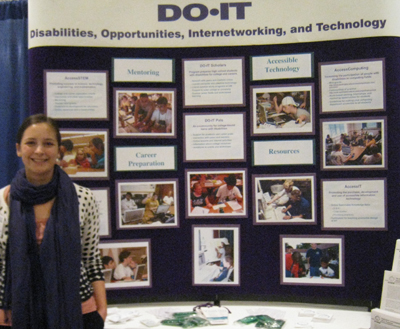
DO-IT staff recently attended the Closing the Gap conference in Minneapolis, MN. Closing the Gap focuses on assistive technology used by students with disabilities and is attended by a mix of educators, therapists, clinicians, and parents. Popular topics this year included the use of new tools like iPods, iPads, and LiveScribe Pens as tools for students with disabilities.
As part of our participation in Closing the Gap, DO-IT presented on Accessible Science Labs and Equipment. We showed one of our latest videos: STEM and People with Disabilities (www.washington.edu/doit/videos/index.php?vid=53). We also talked about strategies for making labs more accessible and demonstrated a variety of accessible science equipment. Participants in the session discussed science labs back at their own schools. We also brought equipment for participants to see, touch, and play with.
DO-IT also hosted a booth in the exhibit hall, distributing information about our programs and resources to conference participants. Individuals were interested to learn more about our resources related to transitioning to college, accessible technology, and universal design.
Design Careers and Students with Disabilities
Opportunities abound for individuals with disabilities in design fields. However, people with disabilities are underrepresented in the design professions. DO-IT is trying to change this situation. With funding from the Institute for Human Centered Design, DO-IT sponsored a two-day workshop as a part of the pilot project, AccessDesign that was held in Seattle this past summer.
At the workshop, students with disabilities and design educators and professionals engaged in a series of interactive sessions. Among the design fields represented were: apparel design, architecture, landscape architecture, urban planning, industrial design, informatics, interior design, graphic design, lighting design, and more.
During the first day of the workshop, held on the University of Washington campus in Seattle, high school and college students with disabilities learned about academic programs in design fields at the UW and other local institutions. Over the course of the day, students met with advisors and faculty in design fields, talked to current students and recent graduates of design programs, learned about other campus resources, and participated in a hands-on design activity to learn about accessibility.
The second day of the workshop was held at an architecture firm where students had the opportunity to learn more about careers in design fields. In addition to a panel presentation and informational interviews with professionals in various design fields, students toured the facility and saw several demonstrations of technology being used in architecture firms today. The computer modeling demonstration, model shop, materials library, and graphic design department provided inspiration for the students as they thought about their own careers.
The ultimate goal of AccessDesign is to broaden the participation in design fields to include more individuals with disabilities and to enhance these fields with the talents and perspectives of this underrepresented group.
DO-IT Director Honored—Twice
We are proud to announce that this year, DO-IT director Sheryl Burgstahler won two impressive awards!
First was the Strache Leadership Award, which honors those who work with students as an educator and mentor, while remaining a leader in the fields of disability and assistive technology through publications, presentations and research. The award will be presented to Dr. Burgstahler this spring at the Keynote Address of the California State University at Northridge (CSUN) Technology and Persons with Disabilities Conference. The award is named after Dr. Fred Strache, who, before retiring from CSUN in 2001, held many positions, including Vice President for student affairs. A very active and progressive administrator, his primary focus was always on students.
Dr. Burgstahler received another prestigious award earlier this year. At its annual conference, the Association of Higher Education and Disability (AHEAD) presented the Professional Recognition Award in honor of, and appreciation for outstanding achievement and contributions to the field of higher education and disability. AHEAD is the premiere professional association for disability services personnel. It is committed to full participation of persons with disabilities in postsecondary education, envisioning "educational and societal environments that value disability and embody equality of opportunity."
Dr. Burgstahler responded to these honors by saying that they "acknowledge what can be accomplished by a team of talented staff members who continually look to the students themselves for guidance on what to do next." Congratulations Sheryl!
Tech Tips: Convergence?
Converge (verb)
- to move or cause to move towards the same point
- to meet or cause to meet; join
One of the best parts of working with technology for as long as I have (how many years I won't say) is watching how modern tools develop, are introduced, and embraced or spurned by society. In the field of accessible technology this watching game is made even more interesting as we see the game of "catch-up" played by developers of operating systems, hardware devices, applications and web pages, not to mention those who create the special technology used by people with disabilities to interact with all this cool stuff. As new versions of the foundational technology is released (think smart phones, computers with faster processors, and operating systems), others rush to develop fascinating new ways to work, play and explore in our daily jobs, our learning at school, at home, and for entertainment.
At times it feels as if all these accessibility efforts are converging, coming together to make these tools and diversions available to the greatest portion of society possible. We get glimpses of these possibilities when a computer is available with built-in accessibility for blind people, or we can carry a device that will read to us regardless of our ability to easily process text. The crop of apps for smart phones and tablets continues to ripen and it is a distinct challenge to know about every option for every possible platform someone might want to use. This is a good thing.
On the flip side, it's still apparent that there is much work to be continued. Many developers have no concept of accessible design, and do not include basic elements in their applications that would enable a more widespread and easier use of their product. In my experience, this is not due to any hostility toward accessibility, it's merely a lack of knowledge about why it's important. And that's where we come in.
We are all end users of technology and all have a variety of skills and abilities in using our chosen devices. Without feedback to the vendors and developers, they will not know of any problems with their products. We need to point out when there is a problem, when something "breaks" for us. A succinct email message pointing out a lack of keyboard access, or inability to select text to be used with a reading program may be enough to effect change. You won't know if you're the first or the fiftieth person to report a problem, but it must begin somewhere. Be polite, be brief in describing the problem, and let them know the impact their software has for you. In my experience developers love to solve problems and most of them want to increase the reach of their site or software, not limit it.
For example, a new-to-me-site that allows one to browse new music is called FindNewJams.com. It completely breaks the basic paradigm of browser accessibility by taking over the Tab key to be used as the play/pause control for its built-in audio player. I sent a quick message to their support email listed on their website and, while I haven't heard back yet, I know that they are now aware of the issue and can consider it in future fixes or features.
It is obvious that some sites/services continue to be a challenge, that convergence is still a work in progress. However popular services such as Facebook and Pandora continue to evolve and, at least in the case of Pandora, now have keyboard shortcuts that provide control over the audio system without removing basic browser functionality.
Get online and get active—developers need to learn about the importance of accessibility and the best way for them to do that is to hear directly from users. You can help with convergence!
The Thread: Service Dogs
I wanted to share with you a question posed by a DO-IT Scholar in our Internet discussion forum and some of the responses so that you can get the flavor of the many rich conversations the DO-IT community has online. Some forum posts are edited for clarity and brevity.
I have recently started thinking about acquiring a service dog to increase my independence, reducing my need to rely on others. Could anyone who happens to have a service dog, or knows about it, please share their experiences? How has a service dog helped you or someone you know?
DO-IT Ambassador: A service dog is wonderful both as an assistant and as a constant unconditionally loving companion for a person. The only problem I have ever seen with service dogs is that getting them from service dog organizations is a rigorous and very costly expense. In many cases it is cheaper to adopt a dog out of the recommended "good service dog breeds" category and train it yourself. This is an experience I'm going through now with another friend of mine who has started training her six month old boxer mix puppy as a service dog.
DO-IT Mentor: If you train a dog yourself how do you go about getting it certified as a service dog? I have a good friend who is also interested in getting a service dog.
DO-IT Mentor: Service dogs do not have to be certified. They simply have to be trained to provide a disability-related service for a human with a disability. Some folks like having them wear an "I'm working" sign or vest to make them more easily identifiable. But there is no certifying agency for them.
DO-IT Ambassador: You are right. I was told that you only need a letter from your doctor explaining the dogs purpose. However, having the dog tested as a good citizen (similar to a service dog test) isn't a bad idea and makes things much more simple.
DO-IT Mentor: Here are some websites that I found helpful with this discussion: www.hum.wa.gov/public-accommodation-pa/use-of-a-trained-service-animal-in-pa and www.deltasociety.org/Page.aspx?pid=304. If you plan to train your own dog, you may find the Delta Society document that describes the minimum standards for service dogs.
How Can You DO-IT?
Sign up to receive DO-IT News if this newsletter was not mailed directly to you.
Volunteer as a Mentor or to help with one of our Summer Study programs.
Pass this newsletter on to someone you know who can benefit from our programs.
Donate money to support and extend DO-IT activities including sponsoring Scholars from states outside of Washington, special events, work-based learning experiences, participant attendant or travel costs, refreshments for program participants, and creation and distribution of educational videotapes and publications.
DO-IT today by completing the form below! You may also make a secure online credit card donation at the University of Washington Make a Gift page by selecting the "DO-IT Program Gift Fund" option.
___ Sign me up to receive copies of DO-IT News, a free program newsletter.
___ Send me more information about DO-IT volunteer opportunities.
___ I would like to make a donation (payable to the University of Washington, Federal ID#91-6001537) to support DO-IT operations.
___ I have enclosed a check for $____________
___ Please charge $____________ to my credit card.
___ VISA ___ Mastercard
Date _____________
Card Number __________________________ Expiration Date _____________
Card Holder Name ___________________________________________________
Signature _____________________________________________________
Address ____________________________________________________________
City __________________________ State _____________ Zip ____________
Phone: Home __________________________ Business ____________________
E-mail: ____________________________________________________________
Your gift is tax-deductible as specified in IRS regulations. Pursuant to RCW 19.09, the University of Washington is registered as a charitable organization with the Secretary of State, State of Washington. For more information, call the Office of the Secretary of State, 1-800-322-4483.
Mail to:
DO-IT
University of Washington
Box 354842
Seattle, WA 98195-4842
Thank you!
More About DO-IT
DO-IT News is published at the University of Washington with input from DO-IT staff, Pals, Scholars, Ambassadors, and Mentors. DO-IT is primarily funded by the National Science Foundation, the U.S. Department of Education, and the State of Washington.
DO-IT (Disabilities, Opportunities, Internetworking, and Technology) serves to increase the successful participation of individuals with disabilities in challenging academic programs such as those in science, engineering, mathematics, and technology. Primary funding for DO-IT is provided by the National Science Foundation, the State of Washington, and the U.S. Department of Education. DO-IT is a collaboration of UW Information Technology and the Colleges of Engineering and Education at the University of Washington.
Grants and gifts fund DO-IT publications, videos, and programs to support the academic and career success of people with disabilities. Contribute today by sending a check to DO-IT, Box 354842, University of Washington, Seattle, WA 98195-4842.
Your gift is tax deductible as specified in IRS regulations. Pursuant to RCW 19.09, the University of Washington is registered as a charitable organization with the Secretary of State, state of Washington. For more information call the Office of the Secretary of State, 1-800-322-4483.
To order free publications or newsletters use the DO-IT Publications Order Form; to order videos and training materials use the Videos, Books and Comprehensive Training Materials Order Form.
For further information, to be placed on the DO-IT mailing list, request materials in an alternate format, or to make comments or suggestions about DO-IT publications or web pages contact:
DO-IT
University of Washington
Box 354842
Seattle, WA 98195-4842
doit@uw.edu
www.uw.edu/doit
206-685-DOIT (3648) (voice/TTY)
888-972-DOIT (3648) (voice/TTY)
206-221-4171 (fax)
509-328-9331 (voice/TTY)
Spokane Founder and Director: Sheryl Burgstahler, Ph.D.